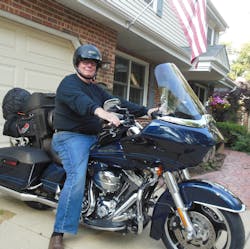I just typed “books on sales skills” into Google and got a mere 352,000,000 hits! Next, I Googled “sales closing skills “and got 109,000,000 hits. Clearly, sales skills and sales closing are very popular subjects.
Each and every author or sales trainer has their own selling style and selling system focusing on the market they cover. However, in the end, all of the books and classes focus on one thing: closing more sales.
Personally, I have been so lucky to have had the opportunity to sell to everyone from Home Depot, Grainger, and Sears to the independent mobile jobber. Sure, there are some differences in how we would structure our presentations, but, when the time comes, it doesn’t matter who you’re presenting to, you must ask for the order. I get a kick out of those who consider the term “consultative selling” as something new. Consultative selling is and always was the way to sell. You consult with your prospect about what they need and then you ask them for the order to close the sale.
The first step is to make sure you are speaking with the decision maker. If you are presenting capital equipment for the shop, you need to be sure that the person you are speaking with is the final decision maker. Simply ask the question: “Is there anyone else who should be seeing this demonstration and is involved with making a final decision?” This gives the prospect a gracious way of telling you that the owner or someone else will make the decision and not them.
Before you begin the actual presentation, you need to ensure your prospect is in a comfortable spot where they can concentrate with as few distractions as possible. The more expensive the product, the more personal the decision becomes. Giving a demonstration while a guy is cutting off an exhaust pipe with an air chisel in the next bay is not the best of locations. Get the prospect in your truck, meet them for lunch or even go to their house.
The first rule in closing the sale is to make the final decision simple.
For instance, if you’re presenting a mega-sized storage unit, help the prospect design the width and drawer configuration as you are going through the feature’s advantages and benefits. This approach gets the prospect talking and participating in the demonstration; it gets their buy-in as you go along and makes them comfortable saying yes. Consider this dialogue as an example:
Jobber: “Do you store your sockets standing up in a holder or do you lay yours on their side in a tray?”
Prospect: “I stand mine up in a holder.”
Jobber: “Great, so we need your unit to have socket drawers tall enough to hold your deep sockets, correct?” (Note: The question “correct’ is very important. It gets your prospect thinking positively about their new cabinet and is a soft trial close.)
Prospect: “Yes.”
Also note that we use the words “you” and “yours” six times in that short exchange. These words help to increase your prospects comfort that they are designing their own personal unit.
As you work through the presentation, get the prospects positive or negative decision on each of the features that fit their needs, including electrical outlets, USB ports, laptop table, etc. Each time you get your prospect to make a decision, they are getting closer to a final “yes.”
The objective is to make your final closing question simple, so getting all the design and other decisions out of the way during your presentation allows you to start closing with a simple, yes-yes close.
Jobber: “Since I don’t want to interrupt your working day, should we deliver your cool new unit in the morning before work or at the end of the working day?”
Another smooth way to get to “yes” easily is to pull out your order form at the beginning of the presentation and fill in the details as the prospect makes decisions. Using this “assumptive close” approach makes it seem like an official order to the prospect from the get-go and again helps them get comfortable with the purchasing process. This way when you get to the end of the presentation you simply put the order form in front of the prospect and point to the spot where they are to sign.
You don’t want to get to the closing part of your demonstration and then have to ask for a lot of decisions. What color do you want? How many drawers do you want? Making a bunch of rapid-fire decisions is likely to get the prospect nervous and nervous customers don’t buy. You want to be sure your prospect has already made most of the decisions before you ask for the order and close the deal.
Unfortunately, the best demonstration and best simple closing questions don’t always get your prospects to say “yes”. So now what?
You can’t just ask, “Why not?” That will put your prospect on the defensive.
If you have helped the prospect make all their design decisions during the demonstration, you can review them to begin to understand where the roadblock is.
Jobber: Ok, I understand that this is an important decision for you. Let’s look at the features you decided on earlier and see where your question is.
Now, simply go back to the beginning and go through the major points one by one while reminding the prospect of the decision they made.
Jobber: You decided you wanted your unit to be 72” wide. Right?
Jobber: You decided that you wanted two 4”-deep drawers on top. Is that still correct?
Continue to go through the features that the prospect selected using the words “you” and “yours” a lot. If there is a problem with the actual product, that issue should show up during this review.
If nothing has been uncovered about the unit that needs to be revised, you can now go with a little tougher close such as “Mr. Prospect we have reviewed all the important features with the unit you designed and you seem to like the unit a lot. Let’s get this unit on order so you can start enjoying your new tool storage unit.”
Now if that doesn’t close the deal you know that something else is stopping the sale. It is probably either a money or a spouse issue.
A possible way to solve a money issue is to break the cost down to the smallest amount.
Jobber: “Sure $300 a month seems like a lot, but it is really only $10 per day and I’m sure the convenience and benefits of your new storage unit is worth it. Just being able to find your tools faster and easier will help you work faster which will improve your paycheck by more than $10 per day, right?”
When the objection is “I need to discuss this with my wife,” you need to try to overcome it right there on the spot.
First, welcome the objection and then say “Let’s get your wife on the phone so I can answer any questions she might have.” Close. Amazingly, sometimes this works.
Without totally aggravating the prospect, try very hard to close the deal that day. The successful closing percentages decrease dramatically with each day that passes.
And finally, remember that no matter how hard it is and how long it takes when you ask for the order, don’t say a word, nothing, nada, not even a grunt or a sigh. Let the prospect think and make a good decision for themselves — and you.
Now go sell something.
About the Author

Alan Sipe
President, Toolbox Sales and Consulting
Alan W. Sipe has spent the last 42 years in the basic hand tool industry including positions as President of KNIPEX Tools North America, Sr. VP Sales and Marketing at Klein Tools, Manager Special Markets at Stanley Tools and sales management at toolbox manufacturer Waterloo Industries. Currently Sipe is the owner of Toolbox Sales and Consulting specializing in sales strategy, structure, development and training. Sipe can be reached at [email protected] or 847-910-1063. Connect with Sipe on LinkedIn.
